Welcome back to "This Day in Scottish History." I'm your host, Colin MacDonald. Today, we travel back to a monumental moment in Scottish history: the Battle of Stirling Bridge, fought on September 11, 1297. This battle, led by William Wallace and Andrew Murray, marked a decisive Scottish victory over the English forces, a turning point in the First War of Scottish Independence. It wasn’t just a battle of swords and strategy but also a clash of determination against a much larger English army. Let’s dive into the events that unfolded on that fateful day.
To understand the significance of the Battle of Stirling Bridge, we must first consider the state of Scotland at the time. In 1296, King Edward I of England had successfully imposed his rule over Scotland after defeating John Balliol and other Scottish nobles at the Battle of Dunbar. Edward’s grip on Scotland seemed firm, but by 1297, resistance had already begun to stir. Andrew Murray led a revolt in the north, reclaiming key fortresses and towns like Inverness, Elgin, and Aberdeen. Meanwhile, in the south, William Wallace was also waging guerrilla warfare against English garrisons. By the time September came, Wallace and Murray had united their forces, their eyes set on Stirling—long regarded as the "key to Scotland."
Stirling’s strategic importance lay in its geography. The River Forth served as a natural barrier, with a narrow, wooden bridge as the only practical crossing point for miles. The English army, led by John de Warenne, Earl of Surrey, and treasurer Hugh de Cressingham, arrived at Stirling with an army of 9,000 men, including 2,000 cavalry. Wallace and Murray, with a force estimated between 5,300 and 6,300 men, awaited them on the north side of the river, camped on Abbey Craig, a high vantage point overlooking the bridge.
The English hesitated for several days, trying to negotiate and size up their opponents. On the morning of September 11, despite better advice from Sir Richard Lundie, who suggested crossing at a ford further upriver, Surrey ordered his troops to march directly across the narrow bridge. This decision proved catastrophic.
The wooden bridge could only accommodate two horsemen side by side, creating a bottleneck that worked perfectly in the Scots’ favor. Wallace and Murray waited until around 2,000 English soldiers had crossed before springing their trap. With a ferocious charge, the Scots spearmen descended from the high ground, cutting off the English advance and gaining control of the bridge’s northern side.
Caught between the Scots and the river, with no hope of reinforcement or retreat, the English soldiers were trapped. The battle turned into a slaughter as the Scots cut down infantry and cavalry alike. Contemporary accounts suggest that as many as 5,000 English infantry were killed in the melee, with hundreds more drowned as they attempted to flee by swimming across the River Forth. Cressingham, despised by the Scots for his harsh tax policies, met a brutal end, with his body famously flayed, and a strip of his skin made into a belt for Wallace’s sword.
By contrast, the Scots suffered relatively few casualties, although Andrew Murray was mortally wounded during the fighting. His death would be felt deeply, as Murray had been a crucial leader alongside Wallace. Nevertheless, the victory at Stirling Bridge galvanized the Scottish resistance. The English fled the battlefield, with Surrey retreating all the way to Berwick, abandoning Stirling Castle and much of the Scottish lowlands to the rebels.
This battle was not just a triumph of arms but of clever tactics. Wallace and Murray used the terrain and the bridge to neutralize the English army’s numerical and cavalry superiority, a testament to their leadership and strategic acumen. The victory also demonstrated that Scotland was far from defeated and could stand against the might of England.
In the aftermath, Wallace was appointed Guardian of Scotland, ruling in the name of the imprisoned John Balliol. His leadership, however, was short-lived. The following year, King Edward I returned with a vengeance, defeating Wallace at the Battle of Falkirk. But the legacy of Stirling Bridge endured, becoming a symbol of Scottish resilience and the fight for independence.
In popular culture, the Battle of Stirling Bridge has been immortalized in various forms. The poet Blind Harry, writing two centuries later, gave us a heavily romanticized and dramatized version of the battle in his Acts and Deeds of Sir William Wallace. Although much of it was fictionalized, it captured the imagination of generations of Scots. And who could forget the 1995 film Braveheart, where Wallace’s exploits were brought to life by Mel Gibson? While the movie took considerable liberties with historical accuracy, omitting the bridge entirely, it nonetheless helped renew interest in this pivotal chapter of Scottish history.
Today, a monument stands on Abbey Craig, overlooking the battlefield and the modern Stirling Bridge, a reminder of Wallace’s and Murray’s stand against English oppression. Their victory at Stirling Bridge remains one of Scotland’s proudest moments—a day when a smaller, determined force triumphed against overwhelming odds.
Thank you for joining me on this journey through Scottish history. Be sure to tune in tomorrow for another episode as we explore more of Scotland’s rich and storied past. I'm Colin MacDonald, and this has been "This Day in Scottish History." Until next time, Haste Ye Back!

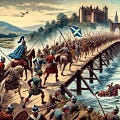
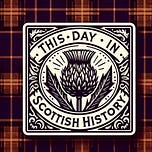


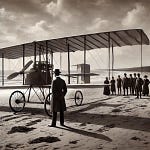
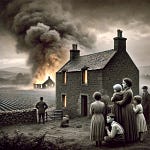

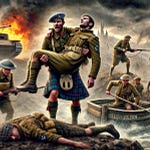

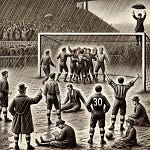

September 11, 1297 - The Battle of Stirling Bridge